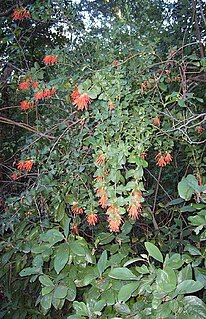
Tristerix is a genus of mistletoe in the family Loranthaceae, native to the Andes, ranging from Colombia and Ecuador to Chile and Argentina. They are woody perennials usually occurring as aerial parasites, are pollinated by hummingbirds and flowerpiercers, with seed-dispersal generally by birds but occasionally by mammals (Dromiciops). The genus is distinguished from other New World Loranthaceae by its simple, terminal, racemose inflorescences, together with its of 4- or 5-merous flowers, versatile anthers, and the presence of endosperm. Further differences include fused cotyledons and the absence of epicortical roots.
Erythrina schliebenii is a species of legume in the family Fabaceae. It is found only in Tanzania. The species is named for German collector and botanist Hans-Joachim Schlieben.

Tapinanthus is a genus of mistletoe in the family Loranthaceae, endemic to Africa. The name of the genus is derived from the Greek tapeinos meaning "low" or "humble" and anthos meaning flower.

Agelanthus is a genus of Afrotropical plants in family Loranthaceae. They grow in trees, including Acacia and Combretum species, as hemiparasitic shrubs of varying sizes. The host plant is penetrated by a single haustorium, and the stems typically have swollen, flower-producing nodes. The flowers are often closely clustered (fascicled) with the five petals (pentamerous) fused into a tube (gamopetalous). The flower may have a swollen base and the tubes open along unilateral, V-shaped splits. The filaments remain spirally rolled inward when the flowers open, while the styles are inconspicuous, slender filaments that are somewhat thickened in the middle. Berries range from pink to orange and red in colour, and are around 1 cm in diameter.

The blue-leaved mistletoe is a species of perennial, parasitic plant in the family Loranthaceae, which is native to the southeastern Afrotropics.
Agelanthus rondensis is a species of hemiparasitic plant in the family Loranthaceae. It is endemic to Tanzania.
Agelanthus atrocoronatus is a species of hemiparasitic plant in the family Loranthaceae. It is endemic to Tanzania. It is known only from the Mufindi Plateau in Tanzania, and was last collected in the 1980s.
Agelanthus kayseri is a species of hemiparasitic plant in the family Loranthaceae, which is native to Kenya, Tanzania and Somalia.
Agelanthus keilii is a species of hemiparasitic plant in the family Loranthaceae, which is native to Rwanda, Tanzania and Burundi.
Agelanthus igneus is a species of hemiparasitic plant in the family Loranthaceae, which is native to Mozambique and Tanzania.
Agelanthus microphyllus is a species of hemiparasitic plant in the family Loranthaceae, which is native to Ethiopia, Kenya and Tanzania.
Agelanthus uhehensis is a species of hemiparasitic plant in the family Loranthaceae, which is native to Tanzania.
Agelanthus validus is a species of hemiparasitic plant in the family Loranthaceae, which is found in the Usambara Mountains, Tanzania
Agelanthus longipes is a species of hemiparasitic plant in the family Loranthaceae, which is found in the Tanzania, Mozambique and Kenya.
Agelanthus myrsinifolius is a species of hemiparasitic plant in the family Loranthaceae, which is native to Rwanda, Zaire and Burundi.
Agelanthus nyasicus is a species of hemiparasitic plant in the family Loranthaceae, which is native to Botswana, Malawi, Mozambique, Tanzania, Zambia, Zaïre and Zimbabwe.

Agelanthus natalitius is a species of hemiparasitic plant in the family Loranthaceae, which is native to the Cape Provinces, KwaZulu-Natal, Mozambique, the Northern Provinces, South Africa, Eswatini and Botswana.

Tristerix aphyllus is a holoparasitic plant species of the genus Tristerix in the family Loranthaceae. It is endemic to Chile. T. aphyllus is sometimes called the "cactus mistletoe." It should not be confused with the mistletoe cactus, which is an epiphytic cactus, and not a mistletoe.
Oncocalyx is a genus of flowering plants belonging to the family Loranthaceae.






